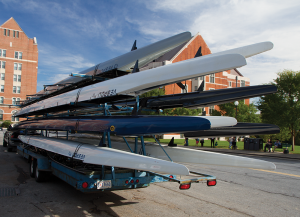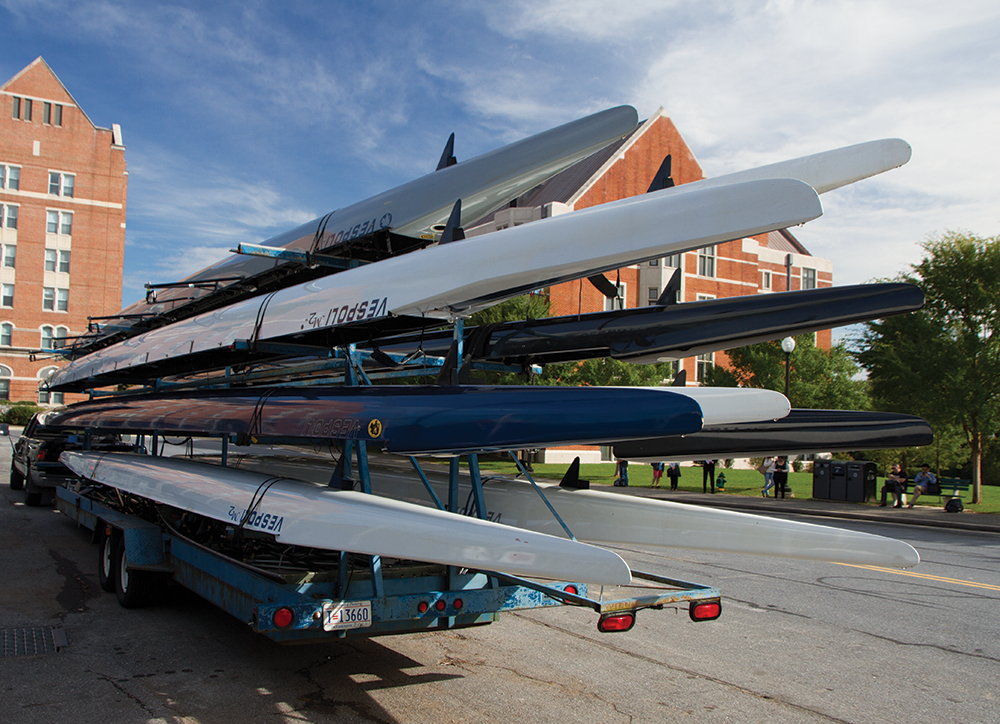
From a makeshift Vietnam memorial on Healy lawn to local news reporters asking for student opinions at the front gates and precious Capitol Hill internship experiences being put on hold, the effects of the shutdown reverberated around Georgetown’s politically inclined campus. For the most part, however, everyday business went on as usual — classes were taught, Leo’s food was served and midterms were survived.
One student group, however, was unable to avoid the consequences of the shutdown: the men’s and women’s rowing teams. The crew teams practice at the Thompson Boat Center, a public facility operated by the National Park Service, which went dormant while Congress labored for weeks to strike a deal to fund the government. Consequently, swift Potomac’s lovely daughters (as the fight song goes) were prevented from training on their usual swath of river.
“We were all keenly aware that people do this sport because they like to row. It was awful that we could not be out on the water,” men’s rowing Head Coach Tony Johnson said. “It was certainly different than what our normal is, but you can ask any varsity rower, we spent a lot of time on some serious land training, and that was not a bad thing.”An ergometer is a machine used to simulate the action of rowing as a treadmill does for running. It is both a rower’s best friend and worst enemy; the idea of a long winter with no other place to practice haunts them, but the machine is necessary for success in the sport.
After spending many years pumping away on the machines in Yates, the University granted the crew teams a room in the basement of the Leavey Center for their ergometers last year. As a result, instead of the pristine, postcard-worthy beauty of the Potomac, the teams have been stuck working out in Leavey’s dungeon as the indie rock hits of Uncommon Grounds echo faintly above. Some team members have even complained that the humidity caused by the activity in the room has caused some of the chemicals from wall paint to release into the air.
“It’s super depressing because we’ve had to go into winter training mode — which is the worst time of the year — early. Everybody wants to be on the river and in nature,” redshirt senior and team leader Ben Holtzmuller said. “The way a boat meshes together is really important, and the best way to develop that team togetherness is to be out on the water and row continuously. We’ve not been able to do that.”
Luckily for the Georgetown rowing program, there is plenty of experience among the student athletes and the coaching staff. In fact, Johnson is in his 18th year with the program, and this was not the first time he has had to endure a government shutdown while coaching at Georgetown.
“I remember ’95, and that was not as hard on us because they did not shut the buildings down like they did this time,” Johnson said. “We were not locked out of our boathouse, so it was not the same in that sense.”
“We have a broad base of leadership throughout the senior class with four very capable captains,” said women’s Head Coach Miranda Paris, who is only in her first season on the Hilltop. They have certainly been impressive in leading the charge, and they’ve proven to be a really resilient group. I was apprehensive at first, but now I am extremely pleased with how they responded and chose to have a positive outlook.”
More than any other team members, the coxswains were harmed the most by the inability to practice on the water. It is their job to coordinate the strokes of the rowers and steer the boat — two things that cannot be simulated on dry land.
“Everyone was affected pretty severely by this situation, but the coxswains have literally been unable to do their entire job,” Holtzmuller said. “Rowing machines don’t float. They can definitely benefit from practicing steering on the water now.”
“Nothing compares to the feeling of being on the water. It’s no fun being stuck in the basement ofLeavey,” junior Bethany Biszko, coxswain for the men’s heavyweight boat said. “When we first heard the government was shutting down, nobody was super excited to be on land. A lot of us are studying government or politics, so it was ironic that we study this while being directly affected in our day-to -ay lives.”
Normally, the crew team practices on the water six days a week from 6:45 a.m. to 9 a.m. During the shutdown, they have been able to load up the vans and make a few trips to row on the waters of theAnacostia River, but not more than twice a week. The lack of a proper practice facility, however, has not affected each coach’s high expectations for the team.
“Ask me again on Monday, but with the crew that I have, I think [we] will do fine,” Johnson said. “Sure, the ability of our crews to perform has been hampered, but we’ll find out just how tough we are over this fall season.”
The deal reached by Congress to fund the government means the crew teams can go back to practicing on the water, at least until the autumn weather turns frigid. But with the culture of brinkmanship so prevalent in our national politics, another shutdown isn’t unlikely. For the Georgetown rowing program, there is one sure-fire way to become shutdown-proof – a boathouse of its own.
“We are actively trying to build a boathouse, We’ve been at it for a long time,” Johnson said. “The National Park Service controls the land, so we have to deal with them. Their view would be that they have to be aware of a lot of different factors; our view is they’re slow. We’ve been at it for years, and we thought we were closet to that 10 years ago.”
For now, the crew teams are looking forward to returning to the Potomac where they can focus on working together as a team, while just a few miles away, our country’s leaders try to figure out how to do the same thing.









